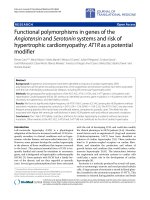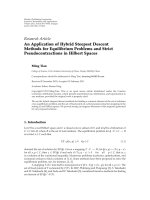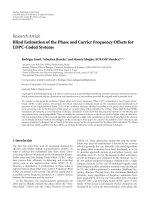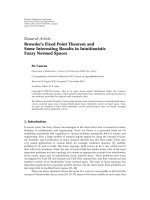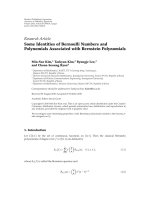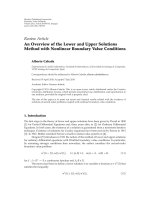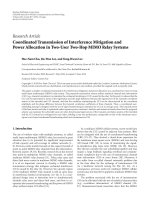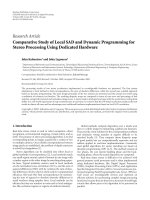báo cáo hóa học:" Review Article An Overview of the Lower and Upper Solutions Method with Nonlinear Boundary Value Conditions" doc
Bạn đang xem bản rút gọn của tài liệu. Xem và tải ngay bản đầy đủ của tài liệu tại đây (538.95 KB, 18 trang )
Hindawi Publishing Corporation
Boundary Value Problems
Volume 2011, Article ID 893753, 18 pages
doi:10.1155/2011/893753
Review Article
An Overview of the Lower and Upper Solutions
Method with Nonlinear Boundary Value Conditions
Alberto Cabada
Departamento de An
´
alise Matem
´
atica, Facultade de Matem
´
aticas, Universidade de Santiago de Compostela,
15782 Santiago de Compostela, Spain
Correspondence should be addressed to Alberto Cabada,
Received 19 April 2010; Accepted 7 July 2010
Academic Editor: Gennaro Infante
Copyright q 2011 Alberto Cabada. This is an open access article distributed under the Creative
Commons Attribution License, which permits unrestricted use, distribution, and reproduction in
any medium, provided the original work is properly cited.
The aim of this paper is to point out recent and classical results related with the existence of
solutions of second-order problems coupled with nonlinear boundary value conditions.
1. Introduction
The first steps in the theory of lower and upper solutions have been given by Picard in 1890
1 for Partial Differential Equations and, three years after, in 2 for Ordinary Differential
Equations. In both cases, the existence of a solution is guaranteed from a monotone iterative
technique. Existence of solutions for Cauchy equations have been proved by Perron in 1915
3. In 1927, M
¨
uller extended Perron’s results to initial value systems in 4.
Dragoni 5 introduces in 1931 the notion of the method of lower and upper solutions
for ordinary differential equations with Dirichlet boundary value conditions. In particular,
by assuming stronger conditions than nowadays, the author considers the second-order
boundary value problem
u
t
f
t, u
t
,u
t
,t∈
a, b
≡ I, u
a
A, u
b
B, 1.1
for f : I × R
2
→ R a continuous function and A, B ∈ R.
The most usual form to define a lower solution is to consider a function α ∈ C
2
I that
satisfies the inequality
α
t
≥ f
t, α
t
,α
t
, 1.2
2 Boundary Value Problems
together with
α
a
≤ A, α
b
≤ B. 1.3
In the same way, an upper solution is a function β ∈ C
2
I that satisfies the reversed
inequalities
β
t
≤ f
t, β
t
,β
t
, 1.4
β
a
≥ A, β
b
≥ B. 1.5
When α ≤ β on I, the existence of a solution of the considered problem lying between
α and β is proved.
In consequence, this method allows us to ensure the existence of a solution of the
considered problem lying between the lower and the upper solution, that is, we have
information about the existence and location of the solutions. So the problem of finding a
solution of the considered problem is replaced by that of finding two well-ordered functions
that satisfy some suitable inequalities.
Following these pioneering results, there have been a large number of works in
which the method has been developed for different kinds of b oundary value problems, thus
first-, second- and higher-order ordinary differential equations with different type of
boundary conditions such as, among others, periodic, mixed, Dirichlet, or Neumann
conditions, have been considered. Also partial differential equations of first and second-order,
have been treated in the literature.
In these situations, we have that for the Neumann problem
u
t
f
t, u
t
,u
t
,u
a
A, u
b
B, 1.6
a lower solution α is a C
2
-function that satisfies 1.2 coupled with the inequalities
α
a
≥ A, α
b
≤ B. 1.7
β ∈ C
2
I is an upper solution of the Neumann problem if it satisfies 1.4 and
β
a
≤ A, β
b
≥ B. 1.8
Analogously, for the periodic problem
u
t
f
t, u
t
,u
t
,u
a
u
b
,u
a
u
b
, 1.9
a lower solution α and an upper solution β are C
2
-functions that satisfy 1.2 and 1.4,
respectively, together with the inequalities
α
a
α
b
,α
a
≥ α
b
,
β
a
β
b
,β
a
≤ β
b
.
1.10
Boundary Value Problems 3
In the classical books of Bernfeld and Lakshmikantham 6 and Ladde et al. 7 the
classical theory of the method of lower and upper solutions and the monotone iterative
technique are given. This gives the solution as the limit of a monotone sequence f ormed by
functions that solve linear problems related to the nonlinear equations considered. We refer
the reader to the classical works of Mawhin 8–11 and the surveys in this field of De Coster
and Habets 12–14 in which one can found historical and bibliographical references together
with recent results and open problems.
It is important to point out that to derive the existence of a solution a growth condition
on the nonlinear part of the equation with respect to the dependence on the first derivative is
imposed. The most usual condition is the so-called Nagumo condition that was introduced
for this author 15 in 1937. This condition imposes, roughly speaking, a quadratic growth in
the dependence of the derivative. The most common form of presenting it is the following.
Definition 1.1. We say that f : I × R
2
→ R satisfies the Nagumo condition if there is h ∈ CI
satisfying
f
t, x, x
≤ h
x
, 1.11
∞
λ
sds
h
s
∞,
1.12
with λb − amax{|βb − αa|, |βa − αb|}.
The main importance of this condition is that it provides a priori bounds on the first
derivative of all the possible solutions of the studied problem that lie between the lower and
the upper solution. A careful proof of this property has been made in 6. One can verify that
in the proof the condition 1.12 can be replaced by the weaker one,
∞
λ
sds
h
s
> max
t∈I
β
t
− min
t∈I
α
t
.
1.13
The usual tool to derive an existence result consists in the construction of a modified
problem that satisfies the two following properties.
1 The nonlinear part of the modified equation is bounded.
2 The nonlinear part of the modified equation coincides with the nonlinear part when
the spatial variable is in α, β.
When the Dirichlet problem 1.1 is studied, the usual truncated problem considered
is
u
t
g
t, u
t
,u
t
≡ f
t, p
t, u
t
,q
u
t
,
u
a
A, u
b
B.
1.14
4 Boundary Value Problems
Here
p
t, x
max
α
t
,
min
x, β
t
, 1.15
q
x
max
{
−K,
{
min
{
x, K
}}}
, 1.16
with
K
λ
sds
h
s
> max
t∈I
β
t
− min
t∈I
α
t
.
1.17
Notice that both p and q are continuous and bounded functions and, in consequence,
if f is continuous, both properties are satisfied by g.
In the proof it is deduced that all the solutions u of the truncated problem 1.14 belong
to the segment α, β and |u
|≤K on I. Notice that the constant K only depends on α, β and
h. The existence of solutions is deduced from fi xed point theory.
It is important to point out that the a priori bound is deduced for all solutions of the
truncated problem. The boundary data is not used. This property is fundamental when more
general situations are considered.
In 1954, Nagumo 16 constructed an example in which the existence of well-ordered
lower and upper solutions is not sufficient to ensure the existence of solutions of a Dirichlet
problem, that is, in general this growth condition cannot be removed for the Dirichlet case.
An analogous result concerning the optimality of the Nagumo condition for periodic and
Sturm-Liouville conditions has been showed recently by Habets and Pouso in 17.
In 1967, Kiguradze 18 proved that it is enough to consider a one-sided Nagumo
condition by eliminating the absolute value in 1.11 to deduce existence results for
Dirichlet problems. Similar results have been given in 1968 by Schrader 19.
Other classical assumptions that impose some growth conditions on the nonlinear part
of the equation are given in 1939 by Tonelli 20. In this situation, considering the Dirichlet
problem 1.1 with A B 0, the following one-sided growth condition is assumed:
f
t, x, y
≥−σ
1
|
x
|
− σ
2
y
− ψ
t
, if x ≥ 0,
f
t, x, y
≤ σ
1
|
x
|
σ
2
y
ψ
t
, if x ≤ 0,
1.18
where ψ ∈ L
1
I and σ
1
,σ
2
≥ 0aresufficiently small numbers.
Different generalizations of these conditions have been developed by, among others,
Epheser 21, K rasnoselskii 22, Kiguradze 23, 24 , Mawhin 25, and Fabry and Habets
26.
In the case of f being a Carath
´
eodory function, the arguments to deduce the existence
result are not a direct translation from the continuous case. This is due to the fact that in the
proof the properties are fulfilled at every point of the interval I. In this new situation the
equalities and inequalities hold almost everywhere and, in consequence, the arguments must
be directed to positive measurable sets. Thus, a suitable truncated problem is the following:
u
t
F
t, u
t
,u
t
≡ f
t, p
t, u
t
,q
d
dt
p
t, u
t
,
1.19
Boundary Value Problems 5
coupled with the corresponding boundary value conditions.
This truncation has been introduced by Gao and Wang in 27 for the periodic problem
and improves a previous one given by Wang et al. in 28. Notice that the function F is
bounded in L
1
I and it is measurable because of the following result proved in 28, Lemma
2.
Lemma 1.2. For any u ∈ C
1
I, the two following properties hold:
ad/dtpt, ut exists for a.e. t ∈ I;
b If u, u
m
∈ C
1
I and u
m
C
1
I
−→ u,then{d/dtpt, u
m
t}→d/dtpt, ut for a.e.
t ∈ I.
When a one-sided Lipschitz condition of the following type:
f
t, x, z
− f
t, y, z
≤ M
x − y
, ∀α
t
≤ x ≤ y ≤ β
t
, 1.20
is assumed on function f for some M>0andallt ∈ I and z ∈ R, it is possible to deduce
the existence of extremal solutions in the sector α, β of the considered problem. By extremal
solutions we mean the greatest and the smallest solutions in the set of all the solutions
in α, β. The deduction of such a property holds from an iterative technique that consists
of solving related linear problems on u and using suitable maximum principles which are
equivalent to the constant sign of the associated Green’s function. One can find in 7 a
complete development of this theory for different kinds of boundary value conditions.
It is important to note that there are many papers that have tried to get existence results
under weaker assumptions on the definition of lower and upper solutions. In particular,
Scorza Dragoni proves in 1938 29, an existence result for the Dirichlet problem by assuming
the existence of two C
1
functions α ≤ β that satisfy
α
t
−
t
f
s, α
s
,α
s
ds,
−β
t
t
f
s, β
s
,β
s
ds
1.21
are nondecreasing in t ∈ I.
Kiguradze uses in 24 regular lower and upper solutions and explain that it is
possible to get the same results for lower and upper solutions whose first derivatives are
not absolutely continuous functions. Ponomarev considers in 30 two continuous functions
α, β : I → R with right Dini derivatives D
r
α, absolute semicontinuous from below in I,and
D
r
β absolute semicontinuous from above in I, t hat satisfy the following inequalities a.e. t ∈ I:
D
r
α
t
≥ f
t, α
t
,D
r
α
t
,
D
r
β
t
≤ f
t, β
t
,D
r
β
t
.
1.22
For further works in this direction see 31–36.
6 Boundary Value Problems
Cherpion et al. prove in 37 the existence of extremal solutions for the Dirichlet
problem without assuming the condition 1.20. In fact, they consider a more general
problem: the ϕ-laplacian equation. In this case, they define a concept of lower and upper
solutions in which some kind of angles are allowed. The definitions are the following.
Definition 1.3. A function α ∈ CI is a lower solution of problem 1.1with A B 0,if
αa ≤ 0, αb ≤ 0, and for any t
0
∈ a, b, either D
−
αt
0
<D
αt
0
, or there exists an open
interval I
0
⊂ I such that t
0
∈ I
0
, α ∈ W
2,1
I
0
and, for a.e. t ∈ I
0
,
α
t
≤ f
t, α
t
,α
t
. 1.23
Definition 1.4. A function β ∈ CI is a lower solution of problem 1.1with A B 0,if
βa ≥ 0, βb ≥ 0, and for any t
0
∈ a, b, either D
−
βt
0
>D
βt
0
, or there exists an open
interval I
0
⊂ I such that t
0
∈ I
0
, β ∈ W
2,1
I
0
and, for a.e. t ∈ I
0
,
β
t
≤ f
t, β
t
,β
t
. 1.24
Here D
, D
, D
−
,andD
−
denote the usual Dini derivatives.
By means of a sophisticated argument, the authors construct a sequence of upper
solutions that converges uniformly to the function defined at each point t ∈ I as the minimum
value attained by all the solutions of problem 1.1 in α, β at this point. Passing to the limit,
they conclude that such function is a solution too. The construction of these upper solutions
is valid only in the case that corners are allowed in the definition. The same idea is valid to
get a maximal solution.
Similar results are deduced for the periodic boundary conditions in 12. In this case
the arguments follow from the finite intersection property of the set of solutions see 38, 39.
2. Two-Point Nonlinear Boundary Value Conditions
Two point nonlinear boundary conditions are considered with the aim of covering more
complicated situations as, for instance, ubu
3
a or u
b − u
aarctanuaub.
In general, the framework of linear boundary conditions cannot be directly translated
to this new situation. For instance, as we have noticed in the previous section, to ensure
existence results for linear boundary conditions, we make use of the fixed point theory. So, in
the case of a Dirichlet problem, the set of solutions of 1.1 coincide with the set of the fixed
points of the operator T : C
1
I → C
1
I, defined by
Tu
t
b
a
G
t, s
f
s, u
s
,u
s
ds
1
b − a
A
b − t
B
t − a
,
2.1
where
G
t, s
1
b − a
⎧
⎨
⎩
a − s
b − t
, if a ≤ s ≤ t ≤ b,
a − t
b − s
, if a ≤ t<s≤ b.
2.2
Boundary Value Problems 7
is the Green’s function related to the linear problem
u
t
0, ∀t ∈ I, u
a
u
b
0. 2.3
It is obvious that when nonlinear boundary value conditions are treated, the operator
whose fixed points are the solutions of the considered problem must be modified.
Moreover the truncations that have to be made in the nonlinear part of the problem
1.14, f or the continuous case, and in 1.19, for the Carath
´
eodory one, must be extended to
the nonlinear boundary conditions. This new truncation on the boundary conditions must
satisfy similar properties to the ones of the nonlinear part of the equation, that is,
1 the modified nonlinear boundary value conditions must be bounded,
2 the modified nonlinear boundary value conditions coincide with the nonmodified
ones in α, β.
So, to deduce existence results for this new situation, it is necessary to make use of
the qualitative properties of continuity and monotonicity of the functions that define the
nonlinear boundary value conditions.
Perhaps the first work that considers nonlinear boundary value conditions coupled
with lower and upper solutions is due to Bebernes and Fraker 40 in 1971. In this work,
the equation u
ft, u, u
coupled with the boundary conditions 0,u0,u
0 ∈ S
1
and
1,u1,u
1 ∈ S
2
is considered. Here, S
1
is compact and connected and S
2
is closed and
connected. Under some additional conditions on the two sets, that include as a particular
case u00; u
1−L
1
u1, the existence result is deduced under the assumption that a
pair of well-ordered lower and upper solutions exist and a Nagumo condition is satisfied.
Later Bernfeld and Lakshmikantham 6 studied the boundary conditions
gua,u
a 0 zua,u
a;withg and z monotone nonincreasing in the second
variable.
Erbe considers in 41 the three types of boundary value conditions:
g
u
a
,u
b
,u
a
,u
b
0,z
u
a
u
b
,
x
u
a
,u
a
0 y
u
a
,u
b
,u
a
,u
b
,
r
u
b
,u
b
0 w
u
a
,u
b
,u
a
,u
b
.
2.4
Here functions g,z,x, y,r and w satisfy suitable monotonicity conditions. Such
monotonicity properties include, as particular cases, the periodic problem in the first situation
and the separated conditions in the second and third cases.
The proofs follow from the study of the Dirichlet problem 1.1 with A ∈ αa,βa
and B ∈ αb,βb. From the monotonicity assumptions it is proved, by a similar argument
to the shooting method, that there is at least a pair A, B for which the boundary conditions
hold.
Mawhin studies in 11 the nonlinear separated boundary conditions
g
a
u
a
,u
a
g
b
u
b
,u
b
0, 2.5
with g
a
x, · and g
b
y, · two nondecreasing functions in R for all x ∈ αa,βa and y ∈
αb,βb.
8 Boundary Value Problems
In this case, he constructs the modified problem
u
t
f
t, p
t, u
t
,u
t
h
u
t
u
t
− p
t, u
t
,
u
a
g
a
p
a, u
a
,u
a
p
a, u
a
,
u
b
−g
b
p
b, u
b
,u
b
p
b, u
b
,
2.6
with h defined in 1.12 and p in 1.15 .
Virzhbitski
˘
ı and Sadyrbaev consider in 42 the conditions
u
0
,u
0
∈ Γ,g
u
0
,u
0
,u
1
,u
1
0, 2.7
where Γ is a continuously parametrized curve in R
2
and g is a continuous function. The
proof is based on reducing the problem to another one with divided boundary conditions
and applying the Bol’-Brauer theorem.
Fabry and Habets treat in 26 the two types of boundary value conditions
g
u
a
,u
a
,u
b
0,z
u
a
u
b
, 2.8
w
u
a
,u
a
,u
b
,u
b
0 r
u
a
,u
b
,u
a
,u
b
, 2.9
with g,z,w,andr monotone functions in some of their variables.
The first case covers the periodic case and the second one separated boundary
conditions.
In the proofs, a more general definition of lower and upper solutions is used. In
particular, they replace the definitions 1.2 and 1.4 by the following ones.
α, β : I → R are continuous functions with right Dini derivatives D
α and D
β
continuous from the right and left Dini derivatives D
−
α and D
−
β such that
1 for all t ∈ I it is satisfied that αt ≤ βt, D
−
αt ≤ D
αt and D
−
βt ≥ D
βt;
2 the functions
D
α
t
−
t
f
s, α
s
,D
α
s
ds,
−D
β
t
t
f
s, β
s
,D
β
s
ds
2.10
are nondecreasing in t.
It is clear that if α and β are C
2
-functions, this definition reduces to 1.2 and 1.4.
Moreover, they assume a more general condition than the Nagumo one.
To deduce existence results for 2.8 they consider a variant of the truncated problem
1.14by adding the term tanh ut − pt, ut coupled with the following nonconstant
Boundary Value Problems 9
Dirichlet boundary conditions:
u
a
p
a, u
a
g
u
a
,u
a
,u
b
,u
b
z
u
a
, 2.11
with p defined in 1.15.
When the conditions 2.9 are studied, the authors consider
u
a
p
a, u
a
w
u
a
,u
a
,u
b
,u
b
,
u
b
p
b, u
a
r
u
a
,u
a
,u
b
,u
b
.
2.12
The proofs follow from oscillation theory and boundedness of the boundary
conditions.
In 43, by using degree theory, Rach
˚
unkov
´
a proves the existence of at least two
different solutions with boundary conditions
g
1
u
a
,u
a
0 g
2
u
b
,u
b
. 2.13
Here, g
1
and g
2
satisfy some suitable monotonicity conditions that cover as a particular
case the separated ones.
In all of the previous works, f is considered a continuous function.
For f being a Carath
´
eodory function Sadyrbaev studies in 44, 45 the first-order
system u
ft, u, v, v
gt, u, v, coupled with boundary value conditions ui,vi ∈
S
i
,i 0, 1, with S
1
,S
2
⊂ R
2
some suitable sets.
Lepin et al. generalize in 31, 34, 35 some of the results proved by Erbe in 41.
Adje generalizes in 46 the results obtained by Fabry and Habets in 26 for problem
2.8 and proves the existence of solution by considering the boundary value conditions
L
1
u
a
,u
b
,u
a
,u
b
0 L
2
u
a
,u
b
, 2.14
and f is a L
p
-Carath
´
eodory function.
Franco and O’Regan, by avoiding some monotonicity assumptions on the boundary
data, introduce in 47 a new definition of coupled lower and upper solutions for the
boundary value conditions 2.9. In this case, the definition of such functions concerns
both of the functions together. Under this definition they cover, under the same notation,
periodic, antiperiodic, and Dirichlet boundary value conditions. Moreover they introduce a
new concept of Nagumo condition as follows.
Definition 2.1. One says that f satisfies a Nagumo condition relative to the interval α, β,
where α is a lower solution and β is an upper solution if for
r
0
max
α
a
− β
b
,
α
b
− β
a
b − a
2.15
10 Boundary Value Problems
there exists a constant M such that
M>max
r
0
, sup
t∈I
α
t
, sup
t∈I
β
t
2.16
and a continuous function ψ : 0, ∞ → 0, ∞ such that
f
t, u, v
≤ ψ
|
v
|
,t∈ I, α
t
≤ u ≤ β
t
,v∈ R,
M
r
0
1
ψ
s
ds > b − a.
2.17
3. ϕ-Laplacian Problems and Functional Boundary Conditions
A more general framework of the second-order general equation u
tft, ut,u
t is
given by the so-called p-laplacian equation. This kind of problems follow the expression
ϕ
p
u
t
f
t, u
t
,u
t
,t∈ I,
3.1
where ϕ
p
xx|x|
p−2
for some p>1. This type of equations appears in the study of
nonNewtonian fluid mechanics 48, 49.
As far as the author is aware, the first reference in which this problem has been studied
in combination with the method of lower and upper solutions is due to De Coster in 50, who
considers 3.1without dependence on u
coupled with Dirichlet conditions. Moreover, she
treat, a more general operator ϕ that includes, as a particular case, the p-laplacian operator.
To be concise, operator ϕ conserves the two main qualitative properties of operator ϕ
p
:
1 ϕ is a strictly increasing homeomorphism from R onto R, such that ϕRR;
2 ϕ00.
As consequence, after this work authors considered the ϕ-laplacian equation
ϕ
u
t
f
t, u
t
,u
t
,t∈ I,
3.2
with ϕ an operator that satisfies the above mentioned properties.
After this paper, the method of lower and upper solutions has been applied to ϕ-
laplacian problems with Mixed boundary conditions in 51 and for Neumann and periodic
boundary conditions in 52.
In this case, the definition of a lower and an upper solution, for f being a Carath
´
eodory
function, is the direct translation to this case for ϕ the identity.
Definition 3.1. A function α ∈ C
1
I is said to be a lower solution for 3.2 if ϕα
∈ W
1,1
I
and
ϕ
α
t
≥ f
t, α
t
,α
t
, for a.e.t∈ I.
3.3
Boundary Value Problems 11
A function β ∈ C
1
I is an upper solution for 3.2 if ϕβ
∈ W
1,1
I and
ϕ
β
t
≤ f
t, β
t
,β
t
, for a.e.t∈ I.
3.4
We will say that u ∈ C
1
I is a solution of 3.2 if it is both a lower and an upper
solution.
Of course, some additional assumptions are needed depending on the considered
boundary conditions, that is, we assume 1.3 and 1.5 for the Dirichlet case, 1.7 and 1.8
for the Neumann case, or 1.10 for the periodic case.
The definition of a Nagumo condition, see 52, is the direct adaptation of the one
used by Adje in 46. Note that such condition does not depend on the boundary data of the
problem.
Definition 3.2. One says that the function f satisfies a Nagumo condition with respect to
continuous functions α and β,withα ≤ β, if there exist k ∈ L
p
I, 1 ≤ p ≤∞, and a continuous
function θ : 0, ∞ → 0, ∞, such that
f
t, u, v
≤ k
t
θ
|
v
|
, on Ω, 3.5
where Ω{t, u, v ∈ R
3
: t ∈ I, αt ≤ u ≤ βt,v∈ R}.
Furthermore
ϕ−ν
−∞
ϕ
−1
u
p−1/p
θ
ϕ
−1
u
du > μ
p−1/p
k
p
∞
ϕν
ϕ
−1
u
p−1/p
θ
ϕ
−1
u
du > μ
p−1/p
k
p
,
3.6
where
μ max
t∈I
β
t
− min
t∈I
α
t
,
ν
max
α
a
− β
b
,
α
b
− β
a
b − a
,
k
p
⎧
⎪
⎪
⎪
⎨
⎪
⎪
⎪
⎩
sup
t∈I
|
k
t
|
, if p ∞,
b
a
|
k
t
|
p
dt
1/p
, if 1 ≤ p<∞.
3.7
If p ∞, we replace p − 1/p 1.
It is obvious that, to construct an operator whose fixed points coincide with the
solutions of the considered problem, there is no possibility of constructing a Green’s function,
so no operator analogous to 2.1 can be given. In this case, one can see 52 that the solutions
12 Boundary Value Problems
of 3.2 coupled with Dirichlet boundary conditions are the fixed points of the operator
L : C
1
I → C
1
I, defined as
Lu
t
A
t
a
ϕ
−1
τ
r
a
f
s, u
s
,u
s
ds
dr,
3.8
where τ is the unique solution of the equation
B − A
b
a
ϕ
−1
τ
r
a
f
s, u
s
,u
s
ds
dr.
3.9
In the previous mentioned papers, the existence of solutions lying between a pair
of well-ordered lower and upper solutions was shown. In 37, the existence of extremal
solutions for the Dirichlet problem is proved. As we have noted earlier, in that paper, a new
definition of lower and upper solutions with corners is used that allows one to construct a
sequence of upper solutions over the function minimum of the solutions in α, β.
Two point nonlinear boundary value conditions have been treated in 53. In this case
ubzua and gua,u
a,u
b 0 have been studied. The monotonicity assumptions
on z and g cover the periodic conditions. The proof follows from a truncated problem on f
as in the nonlinear part of 1.19 and a truncated boundary conditions as in 2.11.
Lepin et al. study in 54 the more general equation ϕt, u, u
ft, u, u
together
with the two point nonlinear boundary conditions
H
1
u
a
,u
b
,u
a
,u
b
h
1
,H
2
u
a
,u
b
,u
a
,u
b
h
2
. 3.10
The existence results are on the basis of the monotone properties of functions H
1
and H
2
.
Functional boundary conditions allow us to consider dependence on some intermedi-
ate points of the interval of definition. This is the case of the multipoint boundary conditions:
u
a
m
i1
a
i
u
τ
i
,u
b
n
i1
b
i
u
η
i
,
3.11
where a<τ
1
<τ
2
< ···<τ
m
<b, a<η
1
<η
2
< ···<η
n
<b,anda
i
, b
j
∈ R have the same sign
for all i ∈{1, ,m} and j ∈{1, ,n}.
Many other type of boundary conditions can be treated, is the case, for i nstance, of the
following:
u
a
max
t∈J
u
t
,J⊂ I,
u
b
J
u
l
s
ds, l ∈ N.
3.12
Boundary Value Problems 13
In this situation, it is necessary to consider functions that are not only defined at the
extremes of the interval, but also in its interior. Such kind of problems have been treated in
55. There the authors consider nonlinear functional boundary conditions of the form
L
1
u
a
,u
b
,u
a
,u
b
,u
0 L
2
u
a
,u
b
, 3.13
with L
1
and L
2
a continuous functions that satisfy certain monotonicity conditions which
include, as particular cases, the periodic ones.
More precisely, it is considered the equation
ϕ
u
t
r
u
t
f
t, u
t
,u
t
, for a.e.t∈ I,
3.14
with r : R → 0, ∞ and 1/r locally bounded possibly discontinuous function and r ◦ ϕ
−1
measurable.
The discontinuity on u
can be eliminated by the use of the transformation ϕ Q ◦ ϕ,
where Q is given by
Q
x
x
0
ds
r
ϕ
−1
s
.
3.15
In this case, the studied problem is translated to the usual ϕ-laplacian
ϕ
u
f
t, u, u
, for a.e.t∈ I,
3.16
and the existence of extremal solutions lying between a pair of well-ordered lower and upper
solutions i s obtained. The results follows from an appropriate truncated problem and the
extension to this case of the arguments used in 37 to get the extremal solutions.
4. General Functional Equations
In this last section, we mention some kind of problems that model different real phenomena
that, as we will see, can be presented under the same formulation.
1 We consider the classical self-adjoint equation
r
t
u
t
f
t, u
t
,u
t
, a.e.t∈ I.
4.1
with r : R → 0, ∞ such that r ∈ L
1
R.
We can formulate the previous equation in the form
d
dt
ϕ
t, u
t
f
t, u
t
,u
t
, a.e.t∈ I,
4.2
14 Boundary Value Problems
with
ϕ
t, x
r
t
x. 4.3
2 We refer t o the usual diffusion equation
k
u
u
t
f
t, u
t
,u
t
, a.e.t∈ I,
4.4
with k : R → 0, ∞ such that k ∈ CR and k ◦ u u
∈ W
1,1
I.
By defining
ϕ
x, y
k
x
y, 4.5
it is possible to rewrite this equation as
d
dt
ϕ
u
t
,u
t
f
t, u
t
,u
t
, a.e.t∈ I.
4.6
3 We study a higher-order differential equation, for instance, the following third-
order problem:
u
t
f
t, u
t
,u
t
,u
t
, a.e.t∈ I,
u
a
0,
u
a
u
b
0.
4.7
By means of the change of variables
u
t
t
a
v
s
ds,
4.8
we arrive at the following equivalent second-order Dirichlet functional equation:
v
t
f
t,
t
a
v
s
ds, v
t
,v
t
≡ g
t, v, v
t
,v
t
, a.e.t∈ I,
v
a
v
b
0.
4.9
Boundary Value Problems 15
4 Consider the following third-order problem:
u
t
f
t, u
t
,u
t
, a.e.t∈ I,
u
a
u
b
0,
u
a
0.
4.10
Using the same change of variable as above, we arrive at the following second-order
differential equation with f unctional boundary conditions:
v
t
f
t, v
t
,v
t
a.e.t∈ I,
v
a
0,
b
a
v
s
ds 0.
4.11
In order to include under the same formulation all the previous problems, the
following equation is considered in 56:
d
dt
ϕ
t, u, u
t
,u
t
f
t, u, u
t
,u
t
, a.e.t∈ I,
4.12
coupled with the nonlinear functional boundary conditions 3.13.
The definitions of the lower and upper solutions cover all the usual cases but the
Nagumo condition does not generalize the case of ϕ depending only on the first derivative
given in Definition 3.2. This gap has been covered in the definition given in 57, where 4.12
is considered coupled with the boundary conditions
L
1
u
a
,u
a
,u
0 L
2
u
b
,u
b
,u
, 4.13
covering in this case the Sturm-Liouville and the multipoint boundary conditions as
particular cases.
5. Final Remarks
It is important to note that in some of the previous results some kind of discontinuities on
the spatial variable are assumed. In this case, some techniques developed by Heikkil
¨
aand
Lakshmikantham in 58 are used.
There is large bibliography on papers related with lower and upper solutions with
nonlinear boundary value conditions for first- and higher-order equations.
Problems with impulses, difference equations, and partial differential equations have
been studied under this point of view for an important number of researchers.
Some theories as the Thompson’s notion of compatibility 59 or the Frigon’s tube-
solutions 60 give some generalizations of the concept of lower and upper solutions that
ensure the existence of solutions of nonlinear boundary problems under weaker assumptions.
16 Boundary Value Problems
Acknowledgments
The author is grateful for professors Jean Mawhin and Felix
ˇ
Z. Sadyrbaev, their interesting
comments have been of great importance in the development of this work. He is also grateful
for the anonymous referees whose useful remarks have made the paper more readable.
This paper was partially supported by Ministerio de Educaci
´
on y Ciencia, Spain, Project
MTM2007-61724.
References
1 E. Picard, “M
´
emoire sur la th
´
eorie des
´
equations aux deriv
´
es partielles et las m
´
ethode des
approximations succesives,” Journal de Math
´
ematiques Pures et Appliqu
´
ees, vol. 6, pp. 145–210, 1890.
2 E. Picard, “Sur l’application des m
´
etodes d’approximations succesives
`
al’
´
etude de certains
´
equations
diff
´
erentielles ordinaires,” Journal de Math
´
ematiques Pures et Appliqu
´
ees, vol. 9, pp. 217–271, 1893.
3 O. Perron, “Ein neuer existenzbeweis f
¨
ur die integrale der differentialgleichung y
f x, y,”
Mathematische Annalen, vol. 76, no. 4, pp. 471–484, 1915.
4 M. M
¨
uller, “
¨
Uber das fundamentaltheorem in der theorie der gew
¨
ohnlichen differentialgleichungen,”
Mathematische Zeitschrift, vol. 26, no. 1, pp. 619–645, 1927.
5 G. S. Dragoni, “II problema dei valori ai limiti studiato in grande per le equazioni differenziali del
secondo ordine,” Mathematische Annalen, vol. 105, no. 1, pp. 133–143, 1931.
6 S. R. Bernfeld and V. Lakshmikantham, An Introduction to Nonlinear Boundary Value Problems,
Mathematics in Science and Engineering, Vol. 10, Academic Press, New York, NY, USA, 1974.
7 G. S. Ladde, V. Lakshmikantham, and A. S. Vatsala, Monotone Iterative Techniques for Nonlinear
Differential Equations, Pitman, Boston, Mass, USA, 1985.
8 J. Mawhin, “Bounded solutions of nonlinear ordinary differential equations,” in Non-Linear Analysis
and Boundary Value Problems for Ordinary Differential Equations (Udine), vol. 371 of CISM Courses and
Lectures, pp. 121–147, Springer, Vienna, Austria, 1996.
9 J. Mawhin, “Boundary value problems for nonlinear ordinary differential equations: from successive
approximations to topology,” in Development of Mathematics 1900–1950 (Luxembourg, 1992), pp. 443–
477, Birkh
¨
auser, Basel, Switzerland, 1994.
10 J. Mawhin, “Twenty years of ordinary differential equations through twelve Oberwolfach meetings,”
Results in Mathematics, vol. 21, no. 1-2, pp. 165–189, 1992.
11 J. Mawhin, Points fixes, points critiques et probl
`
emes aux limites, vol. 92 of S
´
eminaire de Math
´
ematiques
Sup
´
erieures, Presses de l’Universit
´
edeMontr
´
eal, Montreal, Canada, 1985.
12 C. De Coster and P. Habets, Two-Point Boundary Value Problems: Lower and Upper Solutions, vol. 205 of
Mathematics in Science and Engineering, Elsevier, Amsterdam, The Netherlands, 2006.
13 C. De Coster and P. Habets, “The lower and upper solutions method for boundary value problems,” in
Handbook of Differential Equations, pp. 69–160, Elsevier/North-Holland, Amsterdam, The Netherlands,
2004.
14 C. De Coster and P. Habets, “An overview of the method of lower and upper solutions for ODEs,”
in Nonlinear Analysis and Its Applications to Differential Equations, vol. 43 of Progr. Nonlinear Differential
Equations Appl., pp. 3–22, Birkh
¨
auser, Boston, Mass, USA, 2001.
15 M. Nagumo, “Uber die differentialgleichung y
fx, y, y
,” Proceedings of the Physico-Mathematical
Society of Japan, vol. 19, pp. 861–866, 1937.
16 M. Nagumo, “On principally linear elliptic differential equations of the second order,” Osaka Journal
of Mathematics, vol. 6, pp. 207–229, 1954.
17 P. Habets and R. L. Pouso, “Examples of the nonexistence of a solution in the presence of upper and
lower solutions,” The ANZIAM Journal, vol. 44, no. 4, pp. 591–594, 2003.
18 I. T. Kiguradze, “A priori estimates for the derivatives of bounded functions satisfying second-order
differential inequalities,” Differentsial’nye Uravneniya, vol. 3, pp. 1043–1052, 1967 Russian.
19 K. W. Schrader, “Solutions of second order ordinary differential equations,” Journal of Differential
Equations, vol. 4, pp. 510–518, 1968.
20 L. Tonelli, “Sull’equazione differenziale y
fx, y,y
,” Annali della Scuola Normale Superiore di Pisa,
vol. 8, no. 1, pp. 75–88, 1939.
21 H. Epheser, “
¨
Uber die Existenz der L
¨
osungen von Randwertaufgaben mit gew
¨
ohnlichen, nichtlin-
earen Differentialgleichungen zweiter Ordnung,” Mathematische Zeitschrift, vol. 61, pp. 435–454, 1955.
Boundary Value Problems 17
22 M. Krasnoselskii, “On some boundary value problems,” Izvestiya Academy of Sciences USSR, vol. 20,
pp. 241–252, 1956 Russian.
23 I. T. Kiguradze, Some Singular Boundary Value Problems for Ordinary Differential Equations, Izdat. Tbilis.
Univ., Tbilisi, Russia, 1975.
24 I. T. Kiguradze, “Some singular boundary value problems for second order nonlinear ordinary
differential equations,” Differentsial’nye Uravneniya, vol. 4, pp. 1753–1773, 1968 Russian.
25 J. Mawhin, “The Bernstein-Nagumo problem and two-point boundary value problems for ordinary
differential equations,” in Qualitative Theory of Differential Equations, Vol. I, II (Szeged, 1979), vol. 30 of
Colloq. Math. Soc. J
´
anos Bolyai, pp. 709–740, North-Holland, Amsterdam, The Netherlands, 1981.
26 C. Fabry and P. Habets, “Upper and lower solutions for second-order boundary value problems with
nonlinear boundary conditions,” Nonlinear Analysis: Theory, Methods & Applications, vol. 10, no. 10, pp.
985–1007, 1986.
27 W. J. Gao and J. Y. Wang, “On a nonlinear second order periodic boundary value problem with
Carath
´
eodory functions,” Annales Polonici Mathematici, vol. 62, no. 3, pp. 283–291, 1995.
28 M. X. Wang, A. Cabada, and J. J. Nieto, “Monotone method for nonlinear second order periodic
boundary value problems with Carath
´
eodory functions,” Annales Polonici Mathematici, vol. 58, no.
3, pp. 221–235, 1993.
29 S. Scorza Dragoni, “Elementi uniti di transformazioni funzionali e problemi di valori ai limiti Rend,”
Sem. Mat. Univ. Roma, vol. 2, no. 4, pp. 255–275, 1938.
30 V. D. Ponomarev, “The existence of the solution of the simplest boundary value problem for a second-
order differential equation,” Latvi
˘
ıski
˘
ı Matematicheski
˘
ı Ezhegodnik, no. 22, pp. 69–74, 1978
Russian.
31 A. Ya. Lepin, “Existence of solutions of boundary value problems for a second-order equation,”
Differential Equations, vol. 26, no. 10, pp. 1279–1286, 1990.
32 L. A. Lepin, “On the concepts of lower and upper functions,” Differential Equations, vol. 16, no. 10, pp.
1750–1759, 1980 Russian.
33 L. A. Lepin, “Generalized lower and upper functions and their properties,” Latvi
˘
ıski
˘
ı Matematicheski
˘
ı
Ezhegodnik, no. 24, pp. 113–123, 1980 Russian.
34 L. A. Lepin, “Generalized solutions and the solvability of boundary value problems for a second-
order differential equation,” Differential Equations, vol. 18, no. 8, pp. 1323–1330, 1982.
35 A. Ya. Lepin, L. A. Lepin, and V. D. Ponomarev, “Generalized solvability of nonlinear boundary value
problems,” Differential Equations, vol. 22, no. 2, pp. 198–203, 1986.
36 A. Ja. Lepin and F. Zh. Sadyrbaev, “The upper and lower functions method for second order systems,”
Zeitschrift f
¨
ur Analysis und ihre Anwendungen, vol. 20, no. 3, pp. 739–753, 2001.
37 M. Cherpion, C. De Coster, and P. Habets, “Monotone iterative methods for boundary value
problems,” Differential and Integral Equations, vol. 12, no. 3, pp. 309–338, 1999.
38 J.
´
A. Cid, “On extremal fixed points in Schauder’s theorem with applications to differential
equations,” Bulletin of the Belgian Mathematical Society. Simon Stevin, vol. 11, no. 1, pp. 15–20, 2004.
39 J. L. Kelley, General Topology, Graduate Texts in Mathematics, No. 27, Springer, Berlin, Germany, 1975.
40
J. W. Bebernes and R. Fraker, “A priori bounds for boundary sets,” Proceedings of the American
Mathematical Society, vol. 29, pp. 313–318, 1971.
41 L. H. Erbe, “Existence of solutions to boundary value problems for second order differential
equations,” Nonlinear Analysis: Theory, Methods & Applications, vol. 6, no. 11, pp. 1155–1162, 1982.
42 Ya.V.Virzhbitski
˘
ı and F. Zh. Sadyrbaev, “A two-point boundary value problem for a second-order
ordinary differential equation,” Latvi
˘
ıski
˘
ı Matematicheski
˘
ı Ezhegodnik, no. 30, pp. 39–42, 1986 Russian.
43 I. Rach
˚
unkov
´
a, “Upper and lower solutions and multiplicity results,” Journal of Mathematical Analysis
and Applications, vol. 246, no. 2, pp. 446–464, 2000.
44 F. Zh. Sadyrbaev, “Level surfaces of Lyapunov functions and solvability of a two-point boundary
value problem,” Latvi
˘
ıski
˘
ı Matematicheski
˘
ı Ezhegodnik, no. 24, pp. 172–177, 1980 Russian.
45 F.
ˇ
Z. Sadyrbaev, “A two-point boundary value problem for a system of first-order ordinary differential
equations,” Latvi
˘
ıski
˘
ı Matematicheski
˘
ı Ezhegodnik, no. 23, pp. 131–136, 1979 Russian.
46 A. Assohoun, “Sur et sous-solutions g
´
en
´
eralis
´
ees et probl
`
emes aux limites du second ordre,” Bulletin
de la Soci
´
et
´
eMath
´
ematique de Belgique. S
´
erie B, vol. 42, no. 3, pp. 347–368, 1990.
47 D. Franco and D. O’Regan, “Existence of solutions to second order problems with nonlinear boundary
conditions,” Discrete and Continuous Dynamical Systems. Series A, supplement, pp. 273–280, 2003.
48 J. R. Esteban and J. L. V
´
azquez, “On the equation of turbulent filtration in one-dimensional porous
media,” Nonlinear Analysis: Theory, Methods & Applications, vol. 10, no. 11, pp. 1303–1325, 1986.
49 M. A. Herrero and J. L. V
´
azquez, “On the propagation properties of a nonlinear degenerate parabolic
equation,” Communications in Partial Differential Equations, vol. 7, no. 12, pp. 1381–1402, 1982.
18 Boundary Value Problems
50 C. De Coster, “Pairs of positive solutions for the one-dimensional p-Laplacian,” Nonlinear Analysis:
Theory, Methods & Applications, vol. 23, no. 5, pp. 669–681, 1994.
51 J. Wang and W. Gao, “Existence of solutions to boundary value problems for a nonlinear second order
equation with weak Carath
´
eodory functions,” Differential Equations and Dynamical Systems, vol. 5, no.
2, pp. 175–185, 1997.
52 A. Cabada and R. L. Pouso, “Existence result for the problem ϕu
ft, u, u
with periodic and
Neumann boundary conditions,” vol. 30, no. 3, pp. 1733–1742.
53 A. Cabada and R. L. Pouso, “Existence results for the problem ϕu
ft, u, u
with nonlinear
boundary conditions,” Nonlinear Analysis: Theory, Methods & Applications, vol. 35, no. 2, pp. 221–231,
1999.
54 A. Ja. Lepin, L. A. Lepin, and F. Zh. Sadyrbaev, “Two-point b oundary value problems with mono-
tonically boundary conditions for one-dimensional ϕ-Laplacian equations,” Functional Differential
Equations, vol. 12, no. 3-4, pp. 347–363, 2005.
55 A. Cabada and R. L. Pouso, “Extremal solutions of strongly nonlinear discontinuous second-order
equations with nonlinear functional boundary conditions,” Nonlinear Analysis: Theory, Methods &
Applications, vol. 42, no. 8, pp. 1377–1396, 2000.
56 A. Cabada and R. L. Pouso, “Existence theory for functional p-Laplacian equations with variable
exponents,” Nonlinear Analysis: Theory, Methods & Applications, vol. 52, no. 2, pp. 557–572, 2003.
57 A. Cabada, D. O’Regan, and R. L. Pouso, “Second order problems with functional conditions
including Sturm-Liouville and multipoint conditions,” Mathematische Nachrichten, vol. 281, no. 9, pp.
1254–1263, 2008.
58 S. Heikkil
¨
a and V. Lakshmikantham, Monotone Iterative Techniques for Discontinuous Nonlinear
Differential Equations, vol. 181 of Monographs and Textbooks in Pure and Applied Mathematics, Marcel
Dekker, New York, NY, USA, 1994.
59 H. B. Thompson and C. C. Tisdell, “Nonlinear multipoint boundary value problems for weakly
coupled systems,” Bulletin of the Australian Mathematical Society, vol. 60, no. 1, pp. 45–54, 1999.
60 M. Frigon and E. Montoki, “Systems of differential inclusions with maximal monotone terms,” Journal
of Mathematical Analysis and Applications, vol. 323, no. 2, pp. 1134–1151, 2006.
